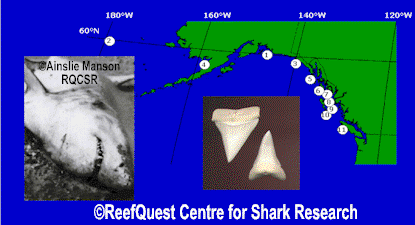Request for Reports of Stranded
White Sharks from the
Pacific Northwest

White Shark (Carcharodon carcharias) strandings are rarely reported. Two cases are known from the Mediterranean and three from California. Only one case each has been reported from British Columbia (BC) and Alaska (AK).
Persistent rumours that "several" other White Shark strandings have occurred in the BC-AK region spurred investigation of this phenomenon since 1986. Data on 16 verified White Shark strandings in this area have come to light, the details of which are presently being prepared for publication in the scientific literature. But biological details such as shark sex and length are scarce, frustrating attempts to identify causal factors.
Reports and evidence of stranded White Sharks from the Pacific Northwest region are eagerly sought.
If you discover a stranded White Shark, check the state of the tides to make sure that you have enough time to process the specimen. Processing depends on the time frame and equipment available, but — ideally — involves five main stages, analysis, documentation, measurement, collection, and dissection. Here's what to do for each of these (with the minimal equipment you'll need in parentheses):
Analyze (no equipment)
-
note the state of the tide and determine how much time you have available; take care that you are not stranded by a flood tide or endangered by a storm
-
make sure the shark is dead; if it shows any responsiveness at all, do not touch it
-
record the date, time, and location as precisely as you can
-
does the shark have broadly triangular, coarsely serrated teeth with non-overlapping bases? If it does, it's definitely a White Shark
-
Approximately how long is the shark? You can estimate this by striding carefully along its length; later you can calibrate your stride length by measuring it several times and taking an average
-
determine the sex of the shark; if it is male, are the claspers rigid and calcified or soft and flexible
-
Are there any marks, injuries, or fishing gear that suggest how the animal may have died?
Document (camera)
-
photograph the whole animal, preferably a lateral (side) view
-
photograph the underside of the head and undersurfaces of the pectoral fins
-
photograph the undersurface of the pelvic fins, medium shot (this helps verify the shark's sex)
-
photograph the teeth, close-up (this validates conclusively the species identification)
Measure (measuring tape)
-
measure the total length of the shark in a straight line (not around the curvature of the body), from tip of the snout to tip of the upper lobe of the caudal (tail) fin; the easiest way to do this is to make a mark by the snout and tail tips and measure the shortest distance between them
-
measure head length (tip of snout to top of 5th gill slit), mouth width, height of an upper tooth and lower tooth as close as possible to the symphysis (center of each jaw); pectoral fin length and width; 1st dorsal fin height and width, and span (total height) of caudal fin
-
if possible, measure the girth (maximum circumference)
Collect (sharp knife or axe)
-
collect upper and lower teeth, especially those near the symphysis
-
collect a 6- to 10-inch (16- to 25- cm) section of vertebral column, from the region just anterior of the 1st dorsal fin
-
collect a sample of muscle tissue from the epaxial (upper back) region (for genetic analysis)
Dissect (sharp knife or axe, measuring tape)
-
if the animal is laying on its back, open the stomach or side, from the cloaca ('anus') to the chest
-
remove the large liver, note the color
-
slit open the stomach and examine the contents; note any identifiable remains, paying particular attention to the smaller bits such as teleost (bony fish) vertebrae, otoliths (ear stones), or lenses from the eyes; if possible, photograph stomach contents too large to retain and preserve unidentifiable hard parts
-
remove stomach and examine reproductive tract; if the specimen is male, note whether the semeniferous ducts are straight or undulating; if female, note color and surface texture of the ovaries as well as the average diameter of any ova at the surface of the ovary. See "Standardized Maturity Stages for Live-Bearing Sharks" for details.
-
if female, examine the uterus; are there any pups? If so note their number, measure and sex each; if possible, photograph and/or preserve the pups
For more about shark strandings in general, click HERE
